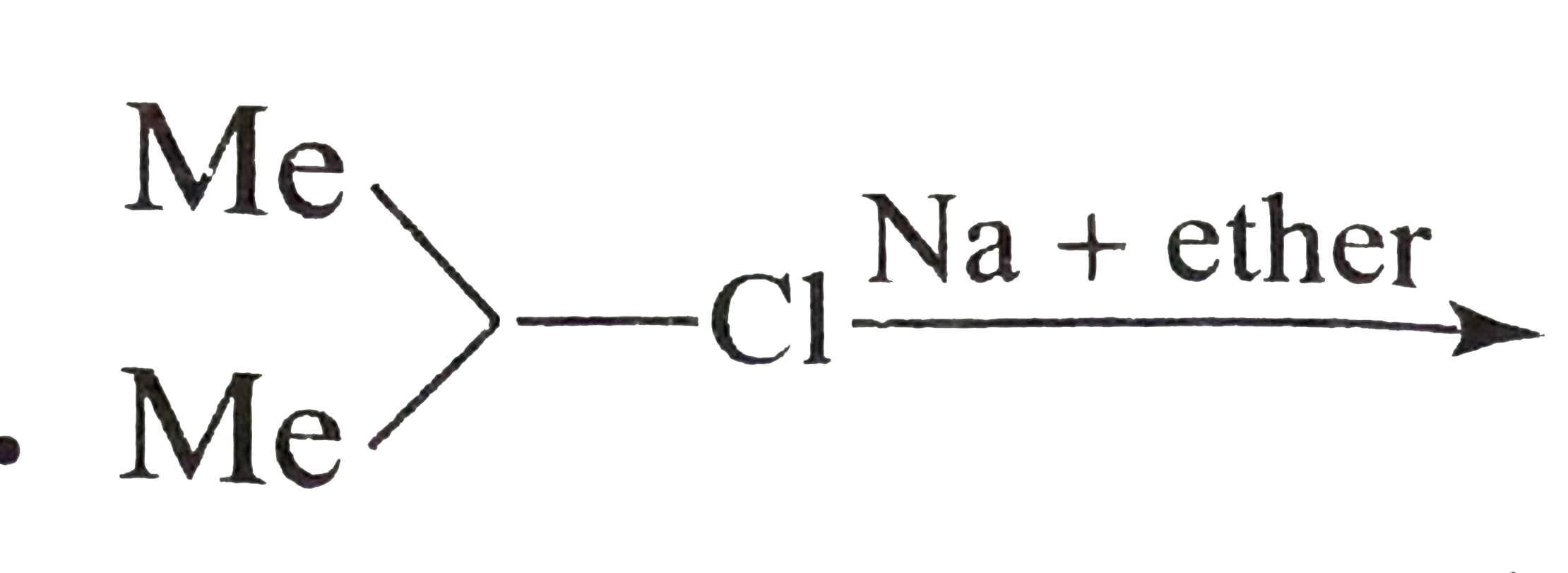In the following sequence of reactions, the products (A) to (G) are formed:
i. 2CH4(g)Δ−−−→1773K(A)(g)+B(g)
ii. 4molof(A)Δ−−−−−−−−−−→Ni(CN)4+THF(C)O3/oxid.−−−−−→(D)only
iii. (A)(1)1molofNaNH2−−−−−−−−−−−→(2)C2H5I(E)3molofE−−−−−−→RedhottubeF⏐↓O3/Red.(G)only
Compounds G is
2-Oxobutanal
2-Oxobutanoic acid
Methylglyoxal
2-Oxopropanoic acid
The correct Answer is:A
To determine the compound G formed in the sequence of reactions, we will analyze each step systematically.
Step 1: Identify Compound A
In the first reaction, we have:
2CH4(g)Δ→(A)(g)+B(g)
When two moles of methane (CH₄) are heated to a high temperature (1773 K), they can decompose to form ethyne (C₂H₂) and hydrogen gas. Thus, compound A is:
A=C2H2 (ethyne)
Step 2: Identify Compound C
Next, we have:
4 mol of (A)Δ→Ni(CN)4+THFC
When ethyne (C₂H₂) is treated with nickel tetracarbonyl (Ni(CN)₄) in tetrahydrofuran (THF), it can undergo a reaction to form a compound that is likely a diene. The exact structure of compound C is not specified, but it is an intermediate formed from the reaction of ethyne.
Step 3: Identify Compound E
Now, we look at the reaction:
(A)(1)1 mol of NaNH2→(2)C2H5IE
Here, ethyne (C₂H₂) reacts with sodium amide (NaNH₂) to form a carbon anion, which then attacks ethyl iodide (C₂H₅I) in an SN2 reaction. This results in the formation of:
E=CH3CH2C≡CH (1-butyne)
Step 4: Identify Compound F
Next, we have:
(3 mol of E) Red hot tube→F
When 1-butyne (C₄H₆) is subjected to high temperatures in a red hot tube, it can undergo rearrangement to form a more stable compound, likely leading to:
F=C6H6 (benzene)
Step 5: Identify Compound G
Finally, we have:
FO3//Red.→G
When benzene (C₆H₆) is treated with ozone (O₃) followed by reduction, it typically leads to the formation of carbonyl compounds. In this case, it can yield:
G=2−oxobutanol (C₄H₈O₂)
Conclusion
Thus, the compound G formed in the sequence of reactions is:
G=2−oxobutanol
In the first reaction, we have:
2CH4(g)Δ→(A)(g)+B(g)
A=C2H2 (ethyne)
Next, we have:
4 mol of (A)Δ→Ni(CN)4+THFC
Now, we look at the reaction:
(A)(1)1 mol of NaNH2→(2)C2H5IE
E=CH3CH2C≡CH (1-butyne)
Next, we have:
(3 mol of E) Red hot tube→F
F=C6H6 (benzene)
Finally, we have:
FO3//Red.→G
G=2−oxobutanol (C₄H₈O₂)
Thus, the compound G formed in the sequence of reactions is:
G=2−oxobutanol
Topper's Solved these Questions
- ALKYNESBOOK - CENGAGE CHEMISTRY ENGLISHCHAPTER - ALKYNESEXERCISE - Exercises (Multiple Correct Answers Type)
25 Videos
- ALKYNESBOOK - CENGAGE CHEMISTRY ENGLISHCHAPTER - ALKYNESEXERCISE - Exercises (Single Correct Answers Type)
30 Videos
- ALKYNESBOOK - CENGAGE CHEMISTRY ENGLISHCHAPTER - ALKYNESEXERCISE - Exercises (Subjective Type)
31 Videos
- ALKENES AND ALKADIENESBOOK - CENGAGE CHEMISTRY ENGLISHCHAPTER - ALKENES AND ALKADIENESEXERCISE - Single correct Answer
14 Videos
- APPENDIX - INORGANIC VOLUME 1BOOK - CENGAGE CHEMISTRY ENGLISHCHAPTER - APPENDIX - INORGANIC VOLUME 1EXERCISE - chapter-7 Single correct answer
1 Videos
Similar Questions
In the following sequence of reactions, the products (A) to (G) are formed:
i. 2CH4(g)Δ−−−→1773K(A)(g)+B(g)
ii. 4molof(A)Δ−−−−−−−−−−→Ni(CN)4+THF(C)O3/oxid.−−−−−→(D)only
iii. (A)(1)1molofNaNH2−−−−−−−−−−−→(2)C2H5I(E)3molofE−−−−−−→RedhottubeF⏐↓O3/Red.(G)only
Compound (E) is
View SolutionIn the following sequence of reactions, the products (A) to (G) are formed:
i. 2CH4(g)Δ−−−→1773K(A)(g)+B(g)
ii. 4molof(A)Δ−−−−−−−−−−→Ni(CN)4+THF(C)O3/oxid.−−−−−→(D)only
iii. (A)(1)1molofNaNH2−−−−−−−−−−−→(2)C2H5I(E)3molofE−−−−−−→RedhottubeF⏐↓O3/Red.(G)only
Compound F is
View Solution
Knowledge Check
 Br2−−→CCl4(i)alc. KOH−−−−−−−→(ii)NaNH2(A)major, Product (A) is :AH2C=CH−CH=CH2BCH3−C≡C−CH3CCH3−CH2−C≡CHDCH3−CH=C=CH2
Br2−−→CCl4(i)alc. KOH−−−−−−−→(ii)NaNH2(A)major, Product (A) is :AH2C=CH−CH=CH2BCH3−C≡C−CH3CCH3−CH2−C≡CHDCH3−CH=C=CH2H3C−CH3∣C∣CH3−H+CCl4R2O2−−→hvProduct :
AH3C−CH3∣C∣CH3−ClBCHCl3CBoth (a) and (b)DNone of these
In the following sequence of reactions, the products (A) to (G) are formed:
i. 2CH4(g)Δ−−−→1773K(A)(g)+B(g)
ii. 4molof(A)Δ−−−−−−−−−−→Ni(CN)4+THF(C)O3/oxid.−−−−−→(D)only
iii. (A)(1)1molofNaNH2−−−−−−−−−−−→(2)C2H5I(E)3molofE−−−−−−→RedhottubeF⏐↓O3/Red.(G)only
Compound D is:
View SolutionIn the following sequence of reactions, the products (A) to (G) are formed:
i. 2CH4(g)Δ−−−→1773K(A)(g)+B(g)
ii. 4molof(A)Δ−−−−−−−−−−→Ni(CN)4+THF(C)O3/oxid.−−−−−→(D)only
iii. (A)(1)1molofNaNH2−−−−−−−−−−−→(2)C2H5I(E)3molofE−−−−−−→RedhottubeF⏐↓O3/Red.(G)only
Compounds (A) and (B), respectively, are:
View SolutionIn the following sequence of reaction, the product C is
CH3−BrKCN−−→AH2O+−−−→BLiAlH4−−−→EtherC
View Solution (B)2mol−−−−−−→Cl2+hv (C)2mol−−−−−−−−→Alc.KOH
(B)2mol−−−−−−→Cl2+hv (C)2mol−−−−−−−−→Alc.KOH
(D) CH2=CH2−−−−−−−→Δ (E)
The final product (E) is :
View SolutionConsider the following sequence of reactions
C2H5C≡CHCH3MgBr−−−−−→A(1)HCHO−−−−−−→(2)H2O+B
The product (B) is
View SolutionIn the following reaction sequence Y is,
PhOCOCH3AlCl3−−→Δ(X)I2−−−→NaOH(Y)
View Solution
